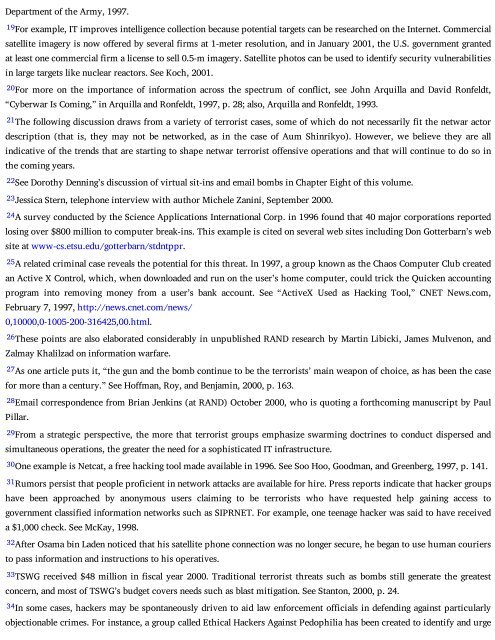RAND_MR1382
Create successful ePaper yourself
Turn your PDF publications into a flip-book with our unique Google optimized e-Paper software.
Department of the Army, 1997.<br />
19 For example, IT improves intelligence collection because potential targets can be researched on the Internet. Commercial<br />
satellite imagery is now offered by several firms at 1-meter resolution, and in January 2001, the U.S. government granted<br />
at least one commercial firm a license to sell 0.5-m imagery. Satellite photos can be used to identify security vulnerabilities<br />
in large targets like nuclear reactors. See Koch, 2001.<br />
20 For more on the importance of information across the spectrum of conflict, see John Arquilla and David Ronfeldt,<br />
“Cyberwar Is Coming,” in Arquilla and Ronfeldt, 1997, p. 28; also, Arquilla and Ronfeldt, 1993.<br />
21 The following discussion draws from a variety of terrorist cases, some of which do not necessarily fit the netwar actor<br />
description (that is, they may not be networked, as in the case of Aum Shinrikyo). However, we believe they are all<br />
indicative of the trends that are starting to shape netwar terrorist offensive operations and that will continue to do so in<br />
the coming years.<br />
22 See Dorothy Denning’s discussion of virtual sit-ins and email bombs in Chapter Eight of this volume.<br />
23 Jessica Stern, telephone interview with author Michele Zanini, September 2000.<br />
24 A survey conducted by the Science Applications International Corp. in 1996 found that 40 major corporations reported<br />
losing over $800 million to computer break-ins. This example is cited on several web sites including Don Gotterbarn’s web<br />
site at www-cs.etsu.edu/gotterbarn/stdntppr.<br />
25 A related criminal case reveals the potential for this threat. In 1997, a group known as the Chaos Computer Club created<br />
an Active X Control, which, when downloaded and run on the user’s home computer, could trick the Quicken accounting<br />
program into removing money from a user’s bank account. See “ActiveX Used as Hacking Tool,” CNET News.com,<br />
February 7, 1997, http://news.cnet.com/news/<br />
0,10000,0-1005-200-316425,00.html.<br />
26 These points are also elaborated considerably in unpublished <strong>RAND</strong> research by Martin Libicki, James Mulvenon, and<br />
Zalmay Khalilzad on information warfare.<br />
27 As one article puts it, “the gun and the bomb continue to be the terrorists’ main weapon of choice, as has been the case<br />
for more than a century.” See Hoffman, Roy, and Benjamin, 2000, p. 163.<br />
28 Email correspondence from Brian Jenkins (at <strong>RAND</strong>) October 2000, who is quoting a forthcoming manuscript by Paul<br />
Pillar.<br />
29 From a strategic perspective, the more that terrorist groups emphasize swarming doctrines to conduct dispersed and<br />
simultaneous operations, the greater the need for a sophisticated IT infrastructure.<br />
30 One example is Netcat, a free hacking tool made available in 1996. See Soo Hoo, Goodman, and Greenberg, 1997, p. 141.<br />
31 Rumors persist that people proficient in network attacks are available for hire. Press reports indicate that hacker groups<br />
have been approached by anonymous users claiming to be terrorists who have requested help gaining access to<br />
government classified information networks such as SIPRNET. For example, one teenage hacker was said to have received<br />
a $1,000 check. See McKay, 1998.<br />
32 After Osama bin Laden noticed that his satellite phone connection was no longer secure, he began to use human couriers<br />
to pass information and instructions to his operatives.<br />
33 TSWG received $48 million in fiscal year 2000. Traditional terrorist threats such as bombs still generate the greatest<br />
concern, and most of TSWG’s budget covers needs such as blast mitigation. See Stanton, 2000, p. 24.<br />
34 In some cases, hackers may be spontaneously driven to aid law enforcement officials in defending against particularly<br />
objectionable crimes. For instance, a group called Ethical Hackers Against Pedophilia has been created to identify and urge










![Genki - An Integrated Course in Elementary Japanese II [Second Edition] (2011), WITH PDF BOOKMARKS!](https://img.yumpu.com/58322134/1/180x260/genki-an-integrated-course-in-elementary-japanese-ii-second-edition-2011-with-pdf-bookmarks.jpg?quality=85)
![Genki - An Integrated Course in Elementary Japanese I [Second Edition] (2011), WITH PDF BOOKMARKS!](https://img.yumpu.com/58322120/1/182x260/genki-an-integrated-course-in-elementary-japanese-i-second-edition-2011-with-pdf-bookmarks.jpg?quality=85)





